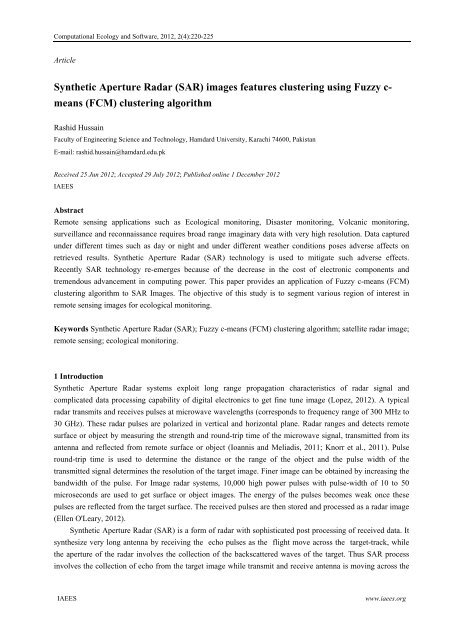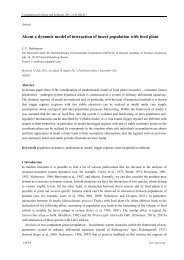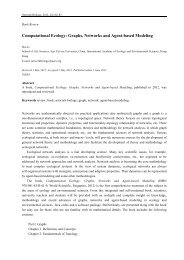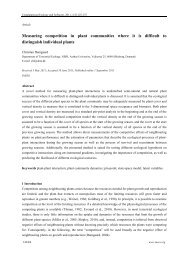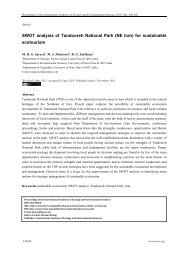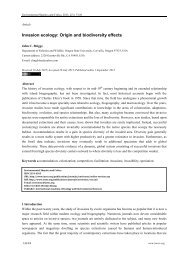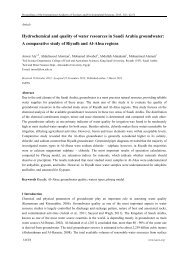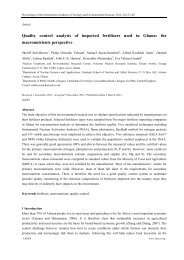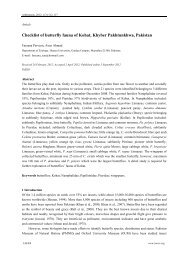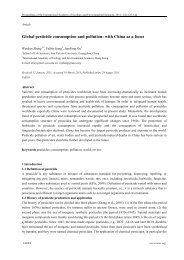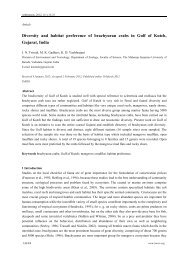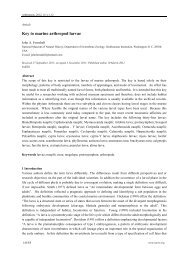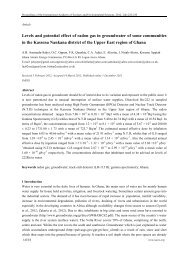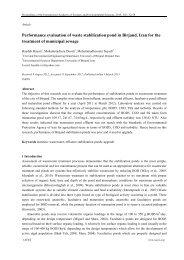Synthetic Aperture Radar (SAR) images features clustering using ...
Synthetic Aperture Radar (SAR) images features clustering using ...
Synthetic Aperture Radar (SAR) images features clustering using ...
You also want an ePaper? Increase the reach of your titles
YUMPU automatically turns print PDFs into web optimized ePapers that Google loves.
Computational Ecology and Software, 2012, 2(4):220-225<br />
Article<br />
<strong>Synthetic</strong> <strong>Aperture</strong> <strong>Radar</strong> (<strong>SAR</strong>) <strong>images</strong> <strong>features</strong> <strong>clustering</strong> <strong>using</strong> Fuzzy c-<br />
means (FCM) <strong>clustering</strong> algorithm<br />
Rashid Hussain<br />
Faculty of Engineering Science and Technology, Hamdard University, Karachi 74600, Pakistan<br />
E-mail: rashid.hussain@hamdard.edu.pk<br />
Received 25 Jun 2012; Accepted 29 July 2012; Published online 1 December 2012<br />
IAEES<br />
Abstract<br />
Remote sensing applications such as Ecological monitoring, Disaster monitoring, Volcanic monitoring,<br />
surveillance and reconnaissance requires broad range imaginary data with very high resolution. Data captured<br />
under different times such as day or night and under different weather conditions poses adverse affects on<br />
retrieved results. <strong>Synthetic</strong> <strong>Aperture</strong> <strong>Radar</strong> (<strong>SAR</strong>) technology is used to mitigate such adverse effects.<br />
Recently <strong>SAR</strong> technology re-emerges because of the decrease in the cost of electronic components and<br />
tremendous advancement in computing power. This paper provides an application of Fuzzy c-means (FCM)<br />
<strong>clustering</strong> algorithm to <strong>SAR</strong> Images. The objective of this study is to segment various region of interest in<br />
remote sensing <strong>images</strong> for ecological monitoring.<br />
Keywords <strong>Synthetic</strong> <strong>Aperture</strong> <strong>Radar</strong> (<strong>SAR</strong>); Fuzzy c-means (FCM) <strong>clustering</strong> algorithm; satellite radar image;<br />
remote sensing; ecological monitoring.<br />
1 Introduction<br />
<strong>Synthetic</strong> <strong>Aperture</strong> <strong>Radar</strong> systems exploit long range propagation characteristics of radar signal and<br />
complicated data processing capability of digital electronics to get fine tune image (Lopez, 2012). A typical<br />
radar transmits and receives pulses at microwave wavelengths (corresponds to frequency range of 300 MHz to<br />
30 GHz). These radar pulses are polarized in vertical and horizontal plane. <strong>Radar</strong> ranges and detects remote<br />
surface or object by measuring the strength and round-trip time of the microwave signal, transmitted from its<br />
antenna and reflected from remote surface or object (Ioannis and Meliadis, 2011; Knorr et al., 2011). Pulse<br />
round-trip time is used to determine the distance or the range of the object and the pulse width of the<br />
transmitted signal determines the resolution of the target image. Finer image can be obtained by increasing the<br />
bandwidth of the pulse. For Image radar systems, 10,000 high power pulses with pulse-width of 10 to 50<br />
microseconds are used to get surface or object <strong>images</strong>. The energy of the pulses becomes weak once these<br />
pulses are reflected from the target surface. The received pulses are then stored and processed as a radar image<br />
(Ellen O'Leary, 2012).<br />
<strong>Synthetic</strong> <strong>Aperture</strong> <strong>Radar</strong> (<strong>SAR</strong>) is a form of radar with sophisticated post processing of received data. It<br />
synthesize very long antenna by receiving the echo pulses as the flight move across the target-track, while<br />
the aperture of the radar involves the collection of the backscattered waves of the target. Thus <strong>SAR</strong> process<br />
involves the collection of echo from the target image while transmit and receive antenna is moving across the<br />
IAEES<br />
www.iaees.org
Computational Ecology and Software, 2012, 2(4):220-225<br />
221<br />
target. The length of the track of the radar that covers the target area determines the resolution of image and is<br />
referred as azimuth. The longer the antenna size the better is the resolution.<br />
As the radar moves relative to the ground, the received pulses are Doppler shifted: positively as it move<br />
away and negatively as it approaches towards the target. These Doppler shifted frequencies should be well<br />
addressed in order to precisely sense the remote object. A number of algorithms have been proposed to address<br />
this issue.<br />
The polarized nature of <strong>Radar</strong> waves make it possible to detect surface changes of certain material<br />
including vegetation or soil moisture. <strong>Radar</strong> antenna receiver and transmitter involve three different<br />
configurations of polarizations which are HH-pol, VV-pol and VH-pols. These configurations are used to<br />
represent three colors in synthesis image. Number of studies has been performed <strong>using</strong> polarization technique,<br />
including (Hashim et al., 1999) for rain forest mapping. (Barotani et al., 1995) presents <strong>SAR</strong> Polarmetric<br />
<strong>features</strong> for agricultural monitoring.<br />
Chirp or pulse compressed signal is widely used in <strong>SAR</strong> systems. The pulse width in chirp radar is much<br />
longer due to which it emits more energy but usually hinder range resolution. Longer pulse width also results<br />
in frequency shift, so the chirped short signal is correlated with the transmitted pulse on its reception. Moreira<br />
and Huang (1994) used Chirp scaling algorithm for high resolution processing of <strong>SAR</strong> data with high squint<br />
angle and motion error.<br />
In this paper we will discuss the application of FCM Algorithm for <strong>SAR</strong> System applications for remote<br />
sensing. A brief description of specialized <strong>SAR</strong> technique termed as Differential <strong>Radar</strong> Interferometry<br />
(DIn<strong>SAR</strong>) is presented in section 2. In section 3, FCM Algorithm applied on <strong>SAR</strong> Image. The paper is<br />
concluded in Section V with future research directions.<br />
2 <strong>SAR</strong> Interferometry<br />
2.1 Defination<br />
<strong>Synthetic</strong> <strong>Aperture</strong> <strong>Radar</strong> (<strong>SAR</strong>) systems record both amplitude and phase of the backscattered echoes. The<br />
phase of the backscattered echoes represents each pixel of the image and is comprised of the following three<br />
components (Rocca and Prati, 2012):<br />
1) Two way travel path from radar antenna to target and from target back to radar antenna.<br />
2) Interaction between the incident and scattered electromagnetic waves.<br />
3) The phase shift induced by the processing system used to focus the image.<br />
Single <strong>SAR</strong> image phase has no practical value. Two <strong>SAR</strong> <strong>images</strong> taken from slightly different angles are<br />
termed as Interferometric pair and their phase difference is termed as Interferometric fringes. The phases of<br />
Interferometric pair can be used to develop Digital Elevation Maps (DEM’s).<br />
2.2 Limitations of DIn<strong>SAR</strong><br />
DIn<strong>SAR</strong> has some limitations which adversely affects the accuracy of the system. One such limitation is due to<br />
the fact that satellite platform do not follows an ideal trajectory. This inaccuracy should be well addressed to<br />
maintain the reliability of the system, and it is termed as Motion Compensation (MoCo).<br />
Another form of inaccuracy is termed as Residual Motion Error (RME’s). This type of inaccuracy is the<br />
result of measurement error due to antenna position, which is in the order of 1-5 cm. In order to address<br />
Motion Compensation and Residual Motion Error in topological variation, number of algorithms has been used.<br />
Some examples are Frequency Division algorithm, Topography and <strong>Aperture</strong> Dependant (TAD) algorithm,<br />
Sub Topography <strong>Aperture</strong> Dependant (SATA) algorithm (de Macedo and Scheiber, 2005).<br />
2.3 <strong>SAR</strong> processing scaling algorithms<br />
IAEES<br />
www.iaees.org
222<br />
Computational Ecology and Software, 2012, 2(4):220-225<br />
The idea behind scaling technique is to improve the accuracy of the phase of complex image, without <strong>using</strong><br />
interpolation to rectify Range Cell Migration. A number of algorithms have been used for data processing<br />
which includes Chirp Scaling Algorithm (CSA), Frequency Scaling Algorithm (FSA) and Extended Frequency<br />
Scaling Algorithm (EFSA) has been proposed (Zhou et al., 2008).<br />
One of the limitations of Chirp Scaling Algorithm is that it cannot be directly applied to dechirp <strong>SAR</strong><br />
processing data. Range Cell Migration (RCM) trajectory corresponds to the frequency of range signal.<br />
Frequency Scaling Algorithm (FSA) is similar to Chirp Scaling Algorithm as it does not require interpolation.<br />
Another improved algorithm proposed by (Gabriel et al., 1989) is Extended Frequency Scaling Algorithm<br />
(EFSA), which is particularly important in case of squint image geometry. This scaling algorithm is an attempt<br />
to improve FSA, because FSA has high sampling rate and larger storage array for a range of spectrum shift<br />
which cause adverse effects on processing of squinted data.<br />
3 Fuzzy Cluster Mapping Applied on <strong>SAR</strong> Image<br />
Fuzzy c-means (FCM) <strong>clustering</strong> algorithm (Dunn, 1974; Cannon et al., 1986) had widely been used for<br />
<strong>clustering</strong> various data set including data related with satellite <strong>images</strong><br />
(HTTP://WWW.JPL.NASA.GOV/RADAR/SIRCX<strong>SAR</strong>/ISABELA.HTM) . This study is an attempt to further explore the<br />
famous FCM algorithm for <strong>SAR</strong> Images. The particular interest here is to monitor the certain <strong>features</strong> of the<br />
satellite image for the object of interest. For example displacement of ice sheets, land sliding, avalanche and<br />
various other parameters can be evaluated for different environmental conditions.<br />
FCM analysis on various <strong>images</strong> is shown in Figs 1-4. Fig. 1(a) is original <strong>SAR</strong> image [image source],<br />
which is used for various experimental setups. Fig. 1(b) and Fig. 1(c) shows visual results of different set of<br />
FCM <strong>using</strong> class 2. This class has low computational complexity (number of iteration and execution time)<br />
and can be used as a bench mark for classes with higher orders. Fig. 2(a) Fig. 2(b) and Fig. 2(c) shows visual<br />
results of different set of FCM <strong>using</strong> class 3. Fig. 3(a) Fig. 3(b) and Fig. 3(c) shows visual results of different<br />
set of FCM <strong>using</strong> class 4.<br />
Fig. 4 and Table 1 shows the computational complexities of three classes used in this analysis. In class 2,<br />
initially 4840 clusters obtains which reduces stabilize to 1651 clusters after seventh iterations. In class 3,<br />
initially 3407 clusters obtains which reduces stabilize to 1042 clusters after seventh iterations. In class 4,<br />
initially 2588 clusters obtains which reduces stabilize to 808 clusters after seventh iterations. When we used<br />
FCM class 4 for the <strong>SAR</strong> image, better <strong>clustering</strong> results obtain at the cost of higher computational complexity<br />
as shown in Fig. 4 and Table1.<br />
(a) (b) (c)<br />
Fig. 1 Visual results of different set of FCM Algorithm (Dunn, 1974) and (Bezdek et al., 1986) (<strong>using</strong> class 2 <strong>clustering</strong>)<br />
IAEES<br />
www.iaees.org
Computational Ecology and Software, 2012, 2(4):220-225<br />
223<br />
(a) (b) (c)<br />
Fig. 2 Visual results of different set of FCM Algorithm (Dunn, 1974) and (Cannon et al., 1986) (<strong>using</strong> class 3 <strong>clustering</strong>)<br />
(a) (b) (c)<br />
Fig. 3 Visual results of different set of FCM Algorithm (Dunn, 1974) and (Cannon et al., 1986) (<strong>using</strong> class 4 <strong>clustering</strong>)<br />
Table 1 Clustering results by <strong>using</strong> FCM algorithm (Dunn, 1974) and (Cannon et.al., 1986). The class 2 with low computational<br />
complexity (number of iteration and execution time) and can be used as a bench mark for classes with higher orders class 3 and<br />
class 4.<br />
Iterations FCM-2 FCM-3 FCM-4<br />
1 4840.115769 3407.017055 2588.334206<br />
2 3950.785278 2633.972645 1975.481975<br />
3 3947.538858 2632.979852 1974.759551<br />
4 3911.997359 2622.011220 1966.795816<br />
5 3582.060563 2511.201795 1887.523555<br />
6 2358.339693 1895.002310 1463.581625<br />
7 1651.986414 1042.747151 808.761810<br />
8 1574.110134 670.480402 511.689643<br />
9 1564.096868 649.178093 491.169070<br />
10 1562.239961 648.080386 486.621747<br />
11 1561.886933 647.814928 466.213148<br />
12 1561.820750 647.686897 411.614598<br />
13 1561.808448 647.615841 377.924829<br />
IAEES<br />
www.iaees.org
224<br />
Computational Ecology and Software, 2012, 2(4):220-225<br />
Fig. 4 Show the <strong>clustering</strong> results by <strong>using</strong> improved FCM algorithm (Dunn, 1974) and (Cannon et.al., 1986). Higher <strong>clustering</strong><br />
performance obtains <strong>using</strong> class 4 (FCM-4). Lower <strong>clustering</strong> performance obtains <strong>using</strong> class 2 (FCM-2).<br />
4 Conclusion<br />
<strong>Synthetic</strong> <strong>Aperture</strong> <strong>Radar</strong> (<strong>SAR</strong>) has become popular in recent years; it covers wide range of military and<br />
civilian remote sensing applications. This paper is an attempt to introduce <strong>Synthetic</strong> <strong>Aperture</strong> <strong>Radar</strong><br />
technology with particular emphasis on feature <strong>clustering</strong> <strong>using</strong> FCM algorithm. This technology is important<br />
for long term monitoring and assessment of remote and hard to reach areas such as glaciers and volcanoes.<br />
Some of the research challenges are measuring target motion compensation, ground moving target imaging<br />
and three dimensional <strong>SAR</strong> image processing.<br />
Acknowledgments<br />
We wish to thank Matthew R. Lopez from Sandia National Laboratories Albuquerque, NM, USA, Ellen<br />
O'Leary from <strong>Radar</strong> Data Center, Jet Propulsion Laboratory Pasadena, CA for facilitating theoretical concepts,<br />
and to the Graduate School of Engineering Sciences and Information Technology, Hamdard University for<br />
their logistic support and services. Images were sourced from<br />
http://www.jpl.nasa.gov/radar/sircxsar/isabela.htm (Last visit: June 18, 2012)<br />
References<br />
Baronti S, Del Frate F, Ferrazzoli P, et al. 1995. <strong>SAR</strong> polarimetric <strong>features</strong> of agricultural areas. International<br />
Journal of Remote Sensing, 14: 2639-2656<br />
Cannon RL, Dave JV, Bezdek JC. 1986. Efficient implementation of the fuzzy c-means <strong>clustering</strong><br />
algorithms. IEEE Transaction on Pattern Analysis and Machine Intelligence, 8(2): 248-255<br />
de Macedo KAC, Scheiber R, 2005. Precise topography- and aperture dependent motion compensation for<br />
airborne <strong>SAR</strong>. IEEE Transactions on Geoscience and Remote Sensing, 2(2): 172–176<br />
IAEES<br />
www.iaees.org
Computational Ecology and Software, 2012, 2(4):220-225<br />
225<br />
Dunn JC. 1974. A fuzzy relative of the ISODATA process and its use in detecting compact well-separated<br />
clusters. Journal of Cybernetics, 3: 32-57<br />
Ellen O'Leary. 2012. <strong>Radar</strong> Data Center, Jet Propulsion Laboratory Pasadena, CA, USA.<br />
http://southport.jpl.nasa.gov/<br />
Gabriel AK, Goldstein RM, Zebker HA. 1989. Mapping small elevation changes over large areas: Differential<br />
radar interferometry. Journal of Geophysical Research, 94: 9183-9191<br />
Hashim M, Hazli W, Kadir W, et al. 1999. Global Rain Forest Mapping Activities in Malaysia: <strong>Radar</strong><br />
Remote Sensing for Forest Survey and Biomass indicators. JERS-1 Science Program ’99 PI Reports.<br />
Ioannis M, Meliadis M. 2011. Multi-temporal Landsat image classification and change analysis of land<br />
cover/use in the Prefecture of Thessaloiniki, Greece. Proceedings of the International Academy of Ecology<br />
and Environmental Sciences, 1(1): 15-25<br />
Knorr W, Pytharoulis I, Petropoulos GP, et al. 2011. Combined use of weather forecasting and satellite remote<br />
sensing information for fire risk, fire and fire impact monitoring. Computational Ecology and Software, 1(2):<br />
112-120<br />
Lopez MR. 2012. Sandia National Laboratories Albuquerque, NM, USA. .<br />
http://www.sandia.gov/radar/sar.html<br />
Moreira A, Huang YH. 1994. Chirp scaling algorithm for processing <strong>SAR</strong> data with high-squint angle and<br />
motion error. Proc. SPIE <strong>SAR</strong> Data Processing for Remote Sensing (Vol. 2316). 269-277<br />
Rocca F, Prati C. 2012. An Overview of <strong>SAR</strong> Interferometry. http://www.elet.polimi.it<br />
Zhu DY, Shen MW, Zhu ZD. 2008. Some aspects of improving the frequency scaling algorithm for<br />
dechirped <strong>SAR</strong> data processing. IEEE Transactions on Geoscience and Remote Sensing, 46(6): 1579-1588<br />
IAEES<br />
www.iaees.org


